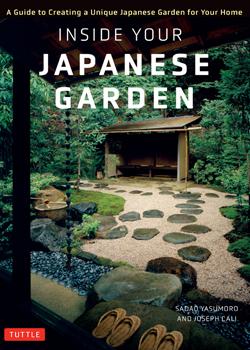Inside Your Japanese Garden: A Guide to Creating a Unique Japanese Garden for your Home

by Sadao Yasumoro and Joseph Cali
Tuttle Publishing (2021)
ISBN: 978-4805316146
Review by Katie Croft
I was introduced to Sadao Yasumoro in Tokyo a few months ago, when he gave me this book. On that day, he was directing work at the site of a new garden project in Naka-Meguro, before taking a group of us to visit some of his completed garden projects (two of which are featured in this book). Despite being in his 80s and with reduced mobility, he maintained enthusiasm, energy and a surprisingly wicked sense of humour throughout the day. Although I didn’t mention it to him then, I was so struck by Yasumoro san’s energy, passion and talent that I immediately decided to review the book for the Japan Society.
Sadao Yasumoro has been building gardens in the Kanto region for over 60 years, where he is a well-respected garden designer. Inside Your Japanese Garden was co-written with Jospeh Cali, who is a graphic designer and author of works including The New Zen Garden. It is part instruction manual and part retrospective of Yasumoro’s work, primarily written for private homeowners who may be looking to create their own Japanese-style garden, or for those who have an amateur interest in Japanese gardens. Cali’s introduction includes an overview of key design and philosophical elements of the Japanese garden and gives some general advice on the approach to garden making. The book is thereafter divided into four sections. The first three sections illustrate gardens that Yasumoro has built, each case study analysed to explain different aspects of garden making: the garden entrance; medium sized gardens; small gardens. The final section gives advice on construction of elements including various types of walls, paths, fences and stone arrangement. There are also detailed construction notes for making various features including koshikake machiai (a covered waiting bench), dobashira (earthen bridge) and amigasa mon (straw hat style gate).
Although this book is suitable for someone without any prior knowledge of Japanese gardens, it has not been oversimplified or dumbed-down. In fact, it includes a great deal of terminology and design features specific to Japanese gardens, and explains a few historical aspects in detail, such as the relation between the garden and the tea ceremony. Cali and Yasumoro admirably try to cover almost everything a person might need to know to build their own Japanese garden. However, it should be noted that detailed information about planting design and onward maintenance of gardens are not included, so if you want to read about pruning etc, this is not the book for you. On the other hand, if you are considering creating a new garden, or you want to understand more about the design approach of a leading Japanese garden maker, you are likely to find the information in here valuable. As Yasumoro is a garden builder, he includes a large quantity of practical information, which is one of the main strengths of this book. Although I can’t claim to have read every book on Japanese gardens, many published in English tend to focus on explaining concepts or history over practicalities. Of course, depending on their interests, I expect that some readers would pore over the detailed construction diagrams for hours, whilst others would find them tedious and skip them immediately.
Throughout the book, the advice is solid but lightly given, without any labouring of ‘rules’ that must be adhered to, or pressure to hone particular skills in advance. In fact, Yasumoro’s encouraging tone assumes that the reader is both willing and able to build their own garden, regardless of experience. As a result, this book is accessible and light-hearted as well as inspirational. Despite the relaxed tone, there is a lot of information packed in from Yasumoro’s decades of experience; and so whilst the reader can gain a lot in a few a lines if they are reading carefully, I have a feeling it would be easy to miss some of the nuance. Yasumoro doesn’t always spell out specific design techniques and doesn’t always explain the rationale behind his design choices. This may be frustrating to serious students of design but is in line with the traditional method of teaching through demonstration and observation, with the expectation that you will find your own path by following the form. And actually, it makes for a more pleasant read. Finally, it should also be noted that some of the practical advice would be difficult to follow for those living in the UK where Japanese materials (such as volcanic soil, kawara roof tiles and fresh bamboo) are not readily available. However, as the first line of this book is: ‘don’t follow this manual,’ I expect that Yasumoro and Cali would be as pleased to see their advice ignored as they would be to see it followed.

